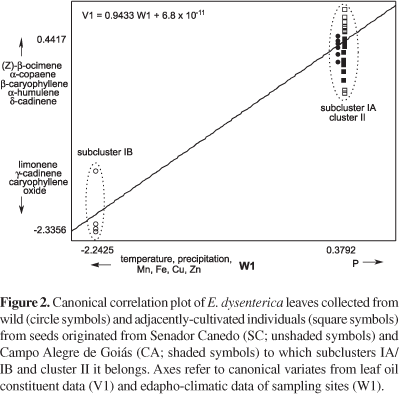Abstracts
The composition of the essential oil of Eugenia dysenterica collected from wild populations in Senador Canedo (SC) and Campo Alegre de Goiás (CA), as well as from cultivated plants growing adjacently from seeds at the same sites has indicated the presence of two oil clusters related to sampling origin. Cluster I included only SC samples, either from the cultivated population (subcluster IA) with high percentages of α-pinene (5.9-13%), β-pinene (6.6-14%) and (Z)-β-ocimene (0-13%), or from the wild population (subcluster IB) with high contents of γ-cadinene (21-34%), limonene (1.3-28%) and caryophyllene oxide (1.5-14%). In cluster II, which included wild and cultivated samples originating from CA seeds, the major constituents were β-caryophyllene (15-44%), δ-cadinene (6.4-21%) and α-copaene (4.4-14%). The canonical correlation revealed that limonene, γ-cadinene, caryophyllene oxide, Zn, Cu, Fe, Mn, and mean monthly temperature and precipitation values were quite strongly related to SC wild samples (subcluster IB), whereas (Z)-β-ocimene, α-copaene, β-caryophyllene, α-humulene, δ-cadinene, and P were related to CA wild samples as well as to all cultivated samples regardless of seed origin. The chemovariation might be genetically determined. In addition, SC samples showed a clear environmental influence.
Eugenia dysenterica; essential oil; chemical variability; seasonal influence; canonical correlation analysis

 Genetic and environmental influence on essential oil composition of Eugenia dysenterica
Genetic and environmental influence on essential oil composition of Eugenia dysenterica


















